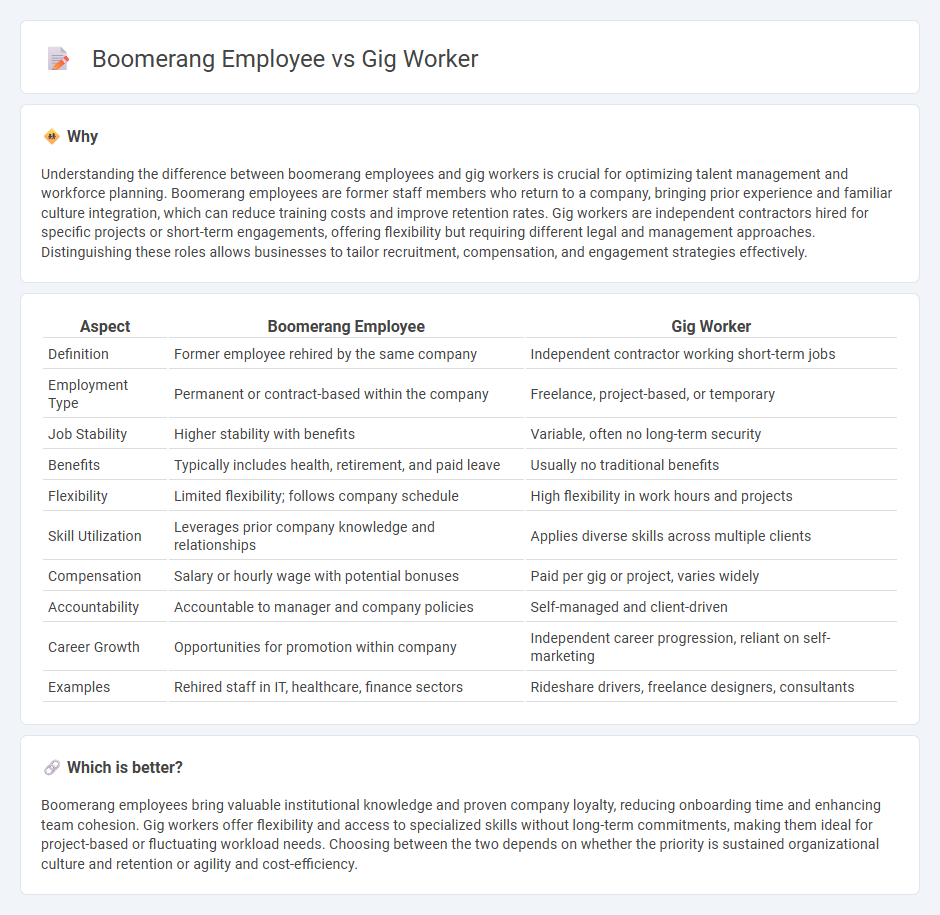
Boomerang employees bring valuable experience and company loyalty by returning to previous employers, creating a unique blend of familiarity and renewed motivation in the workforce. Gig workers, by contrast, contribute flexibility and diverse skills through short-term, project-based roles, shaping the evolving nature of employment relationships. Explore more about how these employment types impact organizational dynamics and career growth.
Why it is important
Understanding the difference between boomerang employees and gig workers is crucial for optimizing talent management and workforce planning. Boomerang employees are former staff members who return to a company, bringing prior experience and familiar culture integration, which can reduce training costs and improve retention rates. Gig workers are independent contractors hired for specific projects or short-term engagements, offering flexibility but requiring different legal and management approaches. Distinguishing these roles allows businesses to tailor recruitment, compensation, and engagement strategies effectively.
Comparison Table
| Aspect | Boomerang Employee | Gig Worker |
|---|---|---|
| Definition | Former employee rehired by the same company | Independent contractor working short-term jobs |
| Employment Type | Permanent or contract-based within the company | Freelance, project-based, or temporary |
| Job Stability | Higher stability with benefits | Variable, often no long-term security |
| Benefits | Typically includes health, retirement, and paid leave | Usually no traditional benefits |
| Flexibility | Limited flexibility; follows company schedule | High flexibility in work hours and projects |
| Skill Utilization | Leverages prior company knowledge and relationships | Applies diverse skills across multiple clients |
| Compensation | Salary or hourly wage with potential bonuses | Paid per gig or project, varies widely |
| Accountability | Accountable to manager and company policies | Self-managed and client-driven |
| Career Growth | Opportunities for promotion within company | Independent career progression, reliant on self-marketing |
| Examples | Rehired staff in IT, healthcare, finance sectors | Rideshare drivers, freelance designers, consultants |
Which is better?
Boomerang employees bring valuable institutional knowledge and proven company loyalty, reducing onboarding time and enhancing team cohesion. Gig workers offer flexibility and access to specialized skills without long-term commitments, making them ideal for project-based or fluctuating workload needs. Choosing between the two depends on whether the priority is sustained organizational culture and retention or agility and cost-efficiency.
Connection
Boomerang employees and gig workers both represent flexible workforce models that emphasize non-traditional employment paths. Boomerang employees return to previous employers, bringing enhanced skills and organizational knowledge, while gig workers operate independently across multiple short-term jobs. Both trends reflect shifts toward dynamic labor markets prioritizing adaptability and project-based engagement.
Key Terms
Flexibility
Gig workers prioritize flexibility by choosing projects and work hours that fit their lifestyle, often leveraging digital platforms to manage multiple clients simultaneously. Boomerang employees gain flexibility by returning to former employers, negotiating roles or schedules that accommodate their evolved work-life balance needs. Explore how flexibility shapes career decisions in dynamic workforce trends.
Rehiring
Rehiring boomerang employees offers companies the advantage of experienced talent familiar with organizational culture, reducing onboarding time and enhancing retention rates. In contrast, gig workers provide flexible, short-term expertise but lack long-term institutional knowledge, limiting their rehiring potential for sustained roles. Discover more about optimizing rehiring strategies to balance the benefits of boomerang employees and gig workers.
Short-term contracts
Gig workers engage in short-term contracts offering flexibility and project-based assignments, often without long-term commitment or benefits. Boomerang employees, by contrast, return to their previous employer after a break, leveraging existing experience for renewed, sometimes temporary, roles. Explore the nuances and benefits of these employment types to optimize workforce strategies.
Source and External Links
What is a gig worker vs. independent contractor? Employer Guide - This guide explains the concept of gig workers and independent contractors, highlighting their flexibility and variety in job opportunities.
What Is a Gig Worker? (And How To Find a Gig Job) - This article discusses what gig work entails and provides steps for finding gig jobs across various industries.
What Is a Gig Worker? Meaning and How To Find Gig Work - This resource defines gig workers and their role in the gig economy, offering insights on finding gig jobs through online platforms.
 dowidth.com
dowidth.com